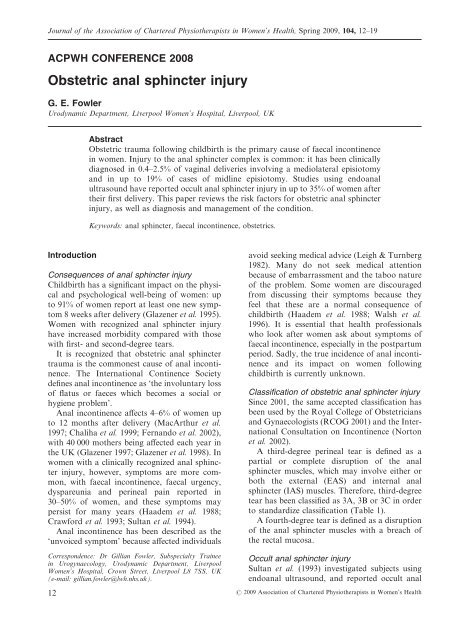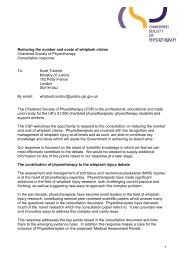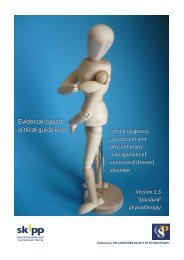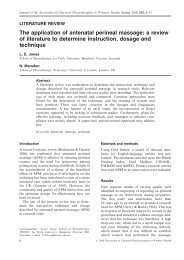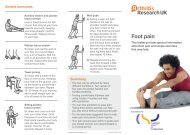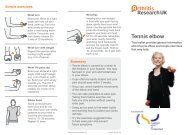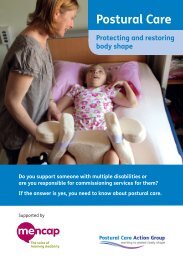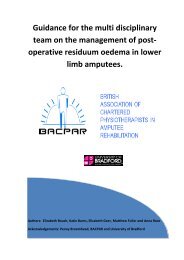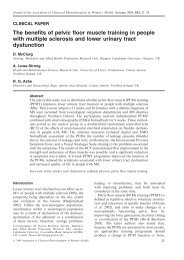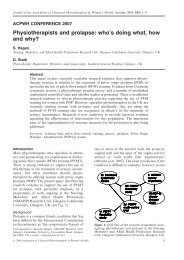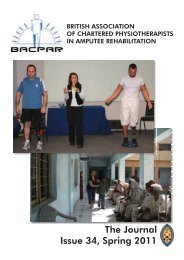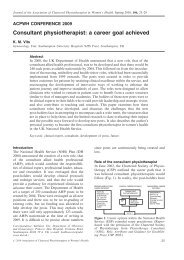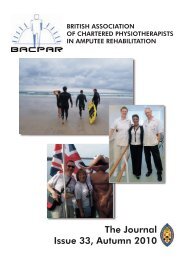Obstetric anal sphincter injury - The Chartered Society of ...
Obstetric anal sphincter injury - The Chartered Society of ...
Obstetric anal sphincter injury - The Chartered Society of ...
Create successful ePaper yourself
Turn your PDF publications into a flip-book with our unique Google optimized e-Paper software.
Journal <strong>of</strong> the Association <strong>of</strong> <strong>Chartered</strong> Physiotherapists in Women’s Health, Spring 2009, 104, 12–19<br />
ACPWH CONFERENCE 2008<br />
<strong>Obstetric</strong> <strong>anal</strong> <strong>sphincter</strong> <strong>injury</strong><br />
G. E. Fowler<br />
Urodynamic Department, Liverpool Women’s Hospital, Liverpool, UK<br />
Introduction<br />
Abstract<br />
<strong>Obstetric</strong> trauma following childbirth is the primary cause <strong>of</strong> faecal incontinence<br />
in women. Injury to the <strong>anal</strong> <strong>sphincter</strong> complex is common: it has been clinically<br />
diagnosed in 0.4–2.5% <strong>of</strong> vaginal deliveries involving a mediolateral episiotomy<br />
and in up to 19% <strong>of</strong> cases <strong>of</strong> midline episiotomy. Studies using endo<strong>anal</strong><br />
ultrasound have reported occult <strong>anal</strong> <strong>sphincter</strong> <strong>injury</strong> in up to 35% <strong>of</strong> women after<br />
their first delivery. This paper reviews the risk factors for obstetric <strong>anal</strong> <strong>sphincter</strong><br />
<strong>injury</strong>, as well as diagnosis and management <strong>of</strong> the condition.<br />
Keywords: <strong>anal</strong> <strong>sphincter</strong>, faecal incontinence, obstetrics.<br />
Consequences <strong>of</strong> <strong>anal</strong> <strong>sphincter</strong> <strong>injury</strong><br />
Childbirth has a significant impact on the physical<br />
and psychological well-being <strong>of</strong> women: up<br />
to 91% <strong>of</strong> women report at least one new symptom<br />
8 weeks after delivery (Glazener et al. 1995).<br />
Women with recognized <strong>anal</strong> <strong>sphincter</strong> <strong>injury</strong><br />
have increased morbidity compared with those<br />
with first- and second-degree tears.<br />
It is recognized that obstetric <strong>anal</strong> <strong>sphincter</strong><br />
trauma is the commonest cause <strong>of</strong> <strong>anal</strong> incontinence.<br />
<strong>The</strong> International Continence <strong>Society</strong><br />
defines <strong>anal</strong> incontinence as ‘the involuntary loss<br />
<strong>of</strong> flatus or faeces which becomes a social or<br />
hygiene problem’.<br />
Anal incontinence affects 4–6% <strong>of</strong> women up<br />
to 12 months after delivery (MacArthur et al.<br />
1997; Chaliha et al. 1999; Fernando et al. 2002),<br />
with 40 000 mothers being affected each year in<br />
the UK (Glazener 1997; Glazener et al. 1998). In<br />
women with a clinically recognized <strong>anal</strong> <strong>sphincter</strong><br />
<strong>injury</strong>, however, symptoms are more common,<br />
with faecal incontinence, faecal urgency,<br />
dyspareunia and perineal pain reported in<br />
30–50% <strong>of</strong> women, and these symptoms may<br />
persist for many years (Haadem et al. 1988;<br />
Crawford et al. 1993; Sultan et al. 1994).<br />
Anal incontinence has been described as the<br />
‘unvoiced symptom’ because affected individuals<br />
Correspondence: Dr Gillian Fowler, Subspecialty Trainee<br />
in Urogynaecology, Urodynamic Department, Liverpool<br />
Women’s Hospital, Crown Street, Liverpool L8 7SS, UK<br />
(e-mail: gillian.fowler@lwh.nhs.uk).<br />
12<br />
avoid seeking medical advice (Leigh & Turnberg<br />
1982). Many do not seek medical attention<br />
because <strong>of</strong> embarrassment and the taboo nature<br />
<strong>of</strong> the problem. Some women are discouraged<br />
from discussing their symptoms because they<br />
feel that these are a normal consequence <strong>of</strong><br />
childbirth (Haadem et al. 1988; Walsh et al.<br />
1996). It is essential that health pr<strong>of</strong>essionals<br />
who look after women ask about symptoms <strong>of</strong><br />
faecal incontinence, especially in the postpartum<br />
period. Sadly, the true incidence <strong>of</strong> <strong>anal</strong> incontinence<br />
and its impact on women following<br />
childbirth is currently unknown.<br />
Classification <strong>of</strong> obstetric <strong>anal</strong> <strong>sphincter</strong> <strong>injury</strong><br />
Since 2001, the same accepted classification has<br />
been used by the Royal College <strong>of</strong> <strong>Obstetric</strong>ians<br />
and Gynaecologists (RCOG 2001) and the International<br />
Consultation on Incontinence (Norton<br />
et al. 2002).<br />
A third-degree perineal tear is defined as a<br />
partial or complete disruption <strong>of</strong> the <strong>anal</strong><br />
<strong>sphincter</strong> muscles, which may involve either or<br />
both the external (EAS) and internal <strong>anal</strong><br />
<strong>sphincter</strong> (IAS) muscles. <strong>The</strong>refore, third-degree<br />
tear has been classified as 3A, 3B or 3C in order<br />
to standardize classification (Table 1).<br />
A fourth-degree tear is defined as a disruption<br />
<strong>of</strong> the <strong>anal</strong> <strong>sphincter</strong> muscles with a breach <strong>of</strong><br />
the rectal mucosa.<br />
Occult <strong>anal</strong> <strong>sphincter</strong> <strong>injury</strong><br />
Sultan et al. (1993) investigated subjects using<br />
endo<strong>anal</strong> ultrasound, and reported occult <strong>anal</strong><br />
2009 Association <strong>of</strong> <strong>Chartered</strong> Physiotherapists in Women’s Health
Table 1. Classification <strong>of</strong> perineal trauma: (EAS) external <strong>anal</strong> <strong>sphincter</strong>; and (IAS) internal <strong>anal</strong><br />
<strong>sphincter</strong><br />
Type <strong>of</strong> tear Definition<br />
First-degree Injury to the perineal skin<br />
Second-degree Injury to the perineum involving the perineal muscles, but not involving the<br />
<strong>anal</strong> <strong>sphincter</strong><br />
Third-degree Injury to the perineum involving the <strong>anal</strong> <strong>sphincter</strong> complex:<br />
(3A) 50% <strong>of</strong> the EAS thickness torn<br />
(3C) both the EAS and the IAS torn<br />
<strong>sphincter</strong> injuries in up to 35% <strong>of</strong> women after<br />
their first delivery, suggesting that the vast<br />
majority <strong>of</strong> <strong>sphincter</strong> injuries are not diagnosed<br />
clinically at time <strong>of</strong> delivery. Since this initial<br />
work, many studies using endo<strong>anal</strong> ultrasound<br />
in the postpartum period have reported occult<br />
<strong>sphincter</strong> rates ranging between 6.8% and 28%<br />
(Varma et al. 1999; Faltin et al. 2000).<br />
One study has gone further, questioning<br />
whether <strong>anal</strong> <strong>sphincter</strong> injuries are truly ‘occult’<br />
or simply missed clinically at the time <strong>of</strong> delivery<br />
(Andrews et al. 2006).<br />
<strong>The</strong>re is no question that the addition <strong>of</strong><br />
postpartum endo<strong>anal</strong> ultrasound increases the<br />
detection <strong>of</strong> <strong>sphincter</strong> <strong>injury</strong> (Faltin et al. 2005;<br />
Andrews et al. 2006). It is also recognized that<br />
symptoms <strong>of</strong> faecal incontinence following an<br />
<strong>anal</strong> <strong>sphincter</strong> <strong>injury</strong> are not commonly reported<br />
in the immediate postpartum period, and many<br />
patients remain asymptomatic for many years.<br />
<strong>The</strong>refore, the diagnosis <strong>of</strong> obstetric <strong>anal</strong> <strong>sphincter</strong><br />
damage is <strong>of</strong>ten delayed for many years, and<br />
the opportunity for early surgical intervention or<br />
physiotherapy input is missed.<br />
<strong>The</strong> importance <strong>of</strong> early diagnosis has been<br />
highlighted in a recent paper (Faltin et al. 2000).<br />
<strong>The</strong> results <strong>of</strong> this randomized controlled trial<br />
(RCT) showed a reduction in faecal incontinence<br />
symptoms at 12 months in women who had a<br />
surgical repair <strong>of</strong> a <strong>sphincter</strong> <strong>injury</strong> diagnosed<br />
by endo<strong>anal</strong> ultrasound at time <strong>of</strong> delivery in<br />
comparison to those who had no repair.<br />
However, there is limited availability <strong>of</strong> endo<strong>anal</strong><br />
ultrasound equipment and staff trained in<br />
its use, as well as poor patient acceptability <strong>of</strong><br />
the technique. Consequently, systematic examination<br />
<strong>of</strong> the perineal area by experienced staff<br />
following delivery remains the method <strong>of</strong> detecting<br />
<strong>sphincter</strong> <strong>injury</strong> in clinical practice, and is<br />
advocated by both midwifery and obstetric<br />
<strong>Obstetric</strong> <strong>anal</strong> <strong>sphincter</strong> <strong>injury</strong><br />
Fourth-degree Injury to the perineum involving the <strong>anal</strong> <strong>sphincter</strong> complex (both the EAS and the<br />
IAS) and <strong>anal</strong> epithelium<br />
colleges, while postpartum endo<strong>anal</strong> ultrasound<br />
remains only a research tool at present.<br />
Risk factors for anorectal <strong>injury</strong><br />
In order to prevent anorectal <strong>injury</strong>, it is important<br />
to identify the risk factors for the condition.<br />
<strong>The</strong> majority <strong>of</strong> research assessing risk factors<br />
relates to third-degree tears. Based on the overall<br />
risk <strong>of</strong> third-degree tears being 1% <strong>of</strong> vaginal<br />
deliveries, a number <strong>of</strong> risk factors have been<br />
identified by retrospective studies. <strong>The</strong>se include<br />
induction <strong>of</strong> labour (up to 2%), epidural <strong>anal</strong>gesia<br />
(up to 2%), birth weight over 4 kg (up to<br />
2%), persistent occipitoposterior position (up to<br />
3%), primiparity (up to 4%), a second stage<br />
longer than one hour (up to 4%) and forceps<br />
delivery (up to 7%) (RCOG 2001). <strong>The</strong>se risk<br />
factors were confirmed by a systematic review<br />
<strong>of</strong> 14 studies (Adams et al. 2001). Other risk<br />
factors, such as shoulder dystocia, have been<br />
suggested, but the evidence is contradictory.<br />
Parity<br />
Some population-based studies <strong>of</strong> faecal incontinence<br />
(FI) have assessed obstetric history.<br />
<strong>The</strong> first vaginal delivery carries the greatest<br />
risk <strong>of</strong> new-onset FI (Zetterstrom et al.<br />
1999; Macarthur et al. 2001), and each subsequent<br />
delivery adds to that risk (Faltin et al.<br />
2001).<br />
Episiotomy<br />
<strong>The</strong>re is conflicting evidence in the literature<br />
regarding episiotomy. Traditional teaching holds<br />
that episiotomy protects the perineum from<br />
uncontrolled trauma during delivery. Although<br />
several authors have demonstrated a protective<br />
effect with mediolateral episiotomy (Anthony<br />
et al. 1994; Poen et al. 1997; de Leeuw et al.<br />
2009 Association <strong>of</strong> <strong>Chartered</strong> Physiotherapists in Women’s Health 13
G. E. Fowler<br />
2001), others have reported the converse (Bek &<br />
Laurberg 1992a; Wood et al. 1998; Buchhave<br />
et al. 1999). <strong>The</strong> type <strong>of</strong> episiotomy is important.<br />
Evidence suggests that mediolateral episiotomy,<br />
which is favoured in UK and European practice,<br />
has a significantly lower risk <strong>of</strong> <strong>sphincter</strong> <strong>injury</strong><br />
in comparison with midline episiotomy, which is<br />
favoured in the USA, and rates <strong>of</strong> 2% versus<br />
12% have been reported (Coats et al. 1980;<br />
Signorello et al. 2000). <strong>The</strong> confusion in the<br />
evidence may be explained by variations in clinical<br />
practice that are not reflected in the above<br />
studies. <strong>The</strong>re will be differences in the experience<br />
<strong>of</strong> the accoucheur for a normal delivery,<br />
and the rate <strong>of</strong> episiotomy also varies. <strong>The</strong><br />
differences between medical and midwifery staff<br />
in conducting a mediolateral episiotomy have<br />
been studied, with doctors performing episiotomies<br />
that are longer and at a wider angle than<br />
those carried out by midwifes (Tincello et al.<br />
2003; Andrews et al. 2005). Current evidence is<br />
unable to support the routine use <strong>of</strong> episiotomy<br />
to prevent <strong>anal</strong> <strong>sphincter</strong> <strong>injury</strong>.<br />
Assisted vaginal delivery<br />
<strong>The</strong> incidence <strong>of</strong> <strong>anal</strong> <strong>sphincter</strong> damage and<br />
faecal incontinence symptoms following instrumental<br />
delivery is higher than following normal<br />
vaginal delivery (Sultan et al. 1993; Donnelly<br />
et al. 1998; Varma et al. 1999). In recent years,<br />
vacuum extractor or ventouse has become the<br />
favoured instrument for assisted vaginal delivery<br />
rather than forceps. This is based on evidence<br />
from many studies, including a Cochrane review<br />
<strong>of</strong> 10 trials showing that the use <strong>of</strong> the vacuum<br />
extractor instead <strong>of</strong> forceps was associated with<br />
significantly less maternal trauma [odds ratio<br />
(OR)=0.4; 95% confidence interval (95%<br />
CI)=0.3–0.5] (Johanson & Menon 1999).<br />
However, compared with forceps delivery,<br />
vacuum extraction is significantly more likely to<br />
fail (OR=1.7; 95% CI=1.3–2.2). In addition, the<br />
neonatal risks associated with ventouse delivery<br />
are greater, with increased risks <strong>of</strong> cephalohaematoma<br />
and retinal haemorrhage (Johanson<br />
& Menon 1999; RCOG 2005).<br />
Other risk factors<br />
Studies assessing the risk factors for neuropathy<br />
following childbirth have reported <strong>injury</strong> to be<br />
more common in the presence <strong>of</strong> a prolonged<br />
labour, particularly a protracted second stage,<br />
and in instances involving a foetus with a large<br />
head (Snooks et al. 1985; Bannister et al. 1987;<br />
Sultan et al. 1994). Many <strong>of</strong> these factors may<br />
14<br />
result in the need for an assisted vaginal delivery.<br />
Further vaginal delivery may result in further<br />
pudendal nerve damage (Kamm 1994).<br />
Many <strong>of</strong> the risk factors identified above are<br />
components <strong>of</strong> normal vaginal delivery and<br />
cannot be avoided. Furthermore, the majority <strong>of</strong><br />
women with these risk factors deliver without<br />
anorectal <strong>injury</strong>. Attempts to develop an antenatal<br />
risk scoring system for <strong>sphincter</strong> <strong>injury</strong><br />
have so far been unsuccessful (Williams et al.<br />
2005b). Studies are needed to assess the effect <strong>of</strong><br />
interventions to prevent <strong>sphincter</strong> <strong>injury</strong>.<br />
Protection against <strong>anal</strong> <strong>sphincter</strong> <strong>injury</strong><br />
Increased awareness <strong>of</strong> the complications <strong>of</strong><br />
childbirth is fuelling requests by women for<br />
elective Caesarean section (CS) in otherwise lowrisk<br />
pregnancies. Indeed, a survey <strong>of</strong> female<br />
obstetricians in 1996 revealed that 31% would<br />
themselves request elective CS because <strong>of</strong> the<br />
potential risk <strong>of</strong> perineal trauma (Al-Mufti et al.<br />
1996). This view contrasts with the recent<br />
National Institute for Clinical Excellence guidelines,<br />
which report an increased risk <strong>of</strong> maternal<br />
morbidity with CS compared with vaginal<br />
delivery (NICE 2004).<br />
Elective CS, as opposed to emergency CS, has<br />
been shown to protect against faecal incontinence<br />
(Macarthur et al. 1997). Studies have<br />
shown that CS late in the first stage <strong>of</strong> labour<br />
(>8 cm dilatation) or in the second stage does<br />
not protect the function <strong>of</strong> the <strong>anal</strong> <strong>sphincter</strong><br />
(Fynes et al. 1998).<br />
Technique and method <strong>of</strong> repair <strong>of</strong><br />
obstetric <strong>anal</strong> <strong>sphincter</strong> <strong>injury</strong><br />
<strong>The</strong> RCOG has produced national guidelines for<br />
the management <strong>of</strong> <strong>anal</strong> <strong>sphincter</strong> <strong>injury</strong> that are<br />
based on the best available evidence (RCOG<br />
2007). Together with a recently published<br />
Cochrane systematic review on the method <strong>of</strong><br />
repair <strong>of</strong> obstetric <strong>anal</strong> <strong>injury</strong> (Fernando et al.<br />
2006b), these provide recommendations on each<br />
aspect <strong>of</strong> <strong>sphincter</strong> repair. <strong>The</strong> RCOG guidelines<br />
can be reviewed online (http://www.rcog.org.uk/<br />
resources/Public/pdf/green_top29_management_<br />
third_minoramend.pdf), and therefore, only the<br />
salient points will be highlighted in the present<br />
paper.<br />
Setting <strong>of</strong> repair<br />
<strong>The</strong> RCOG recommend that repair <strong>of</strong> <strong>anal</strong><br />
<strong>sphincter</strong> <strong>injury</strong> takes place in an operating<br />
theatre. This provides aseptic conditions and<br />
2009 Association <strong>of</strong> <strong>Chartered</strong> Physiotherapists in Women’s Health
adequate light. Regional or general anaesthesia<br />
enables the <strong>sphincter</strong> muscle to relax, enabling<br />
the retracted torn ends to be retrieved and<br />
brought together without tension (Sultan et al.<br />
1999).<br />
Antibiotics<br />
Infection following <strong>anal</strong> <strong>sphincter</strong> repair is<br />
associated with a high risk <strong>of</strong> <strong>anal</strong> incontinence<br />
and fistula formation (Sultan et al. 1999). Intraoperative<br />
intravenous and postoperative oral<br />
broad spectrum antibiotics have been used in all<br />
RCTs assessing different repair techniques.<br />
Typical regimes include cefuroxime 1.5 g and<br />
metronidazole 500 mg in theatre, followed by a<br />
7-day course <strong>of</strong> cephalexin 500 mg and metronidazole<br />
500 mg three times a day (Sultan et al.<br />
1999; Fitzpatrick et al. 2000; Fernando et al.<br />
2006b; Williams et al. 2006).<br />
Laxatives<br />
Traditionally, women received constipating<br />
agents following <strong>sphincter</strong> repair. This was<br />
based on the experience <strong>of</strong> colorectal surgeons<br />
who were undertaking secondary <strong>sphincter</strong><br />
repair on patients with faecal incontinence, and<br />
was intended to avoid liquid faecal matter contaminating<br />
the wound. Primary repair differs<br />
from secondary repair since women do not have<br />
pre-existing faecal incontinence at time <strong>of</strong> repair.<br />
<strong>The</strong> use <strong>of</strong> postoperative laxatives and stool<br />
s<strong>of</strong>teners is supported by the opinion that these<br />
act to avoid passing a hard stool that could, in<br />
turn, disrupt the repair (Sultan et al. 1999).<br />
In the published RCTs, stool s<strong>of</strong>teners (lactulose<br />
10 mL three times a day), together with a<br />
bulking agent (ispaghula husk, Fybogel, one<br />
sachet twice a day) were used for 10 days<br />
following repair.<br />
<strong>The</strong> need for laxatives may be tailored to the<br />
individual women; the dose and type will be<br />
dependent on a patient’s diet, gut transit time<br />
and stool consistency.<br />
Technique <strong>of</strong> repair<br />
<strong>The</strong>re are two recognized methods <strong>of</strong> repairing<br />
torn external <strong>anal</strong> <strong>sphincter</strong> (EAS): end-to-end<br />
(approximation) method and overlap technique.<br />
Traditionally, primary <strong>anal</strong> <strong>sphincter</strong> repair<br />
involved end-to-end repair <strong>of</strong> the torn ends <strong>of</strong><br />
the EAS. Since the publication <strong>of</strong> a retrospective<br />
study that suggested an improved outcome could<br />
be achieved by using an overlap technique<br />
(Sultan et al. 1999), four RCTs have been com-<br />
<strong>Obstetric</strong> <strong>anal</strong> <strong>sphincter</strong> <strong>injury</strong><br />
pleted (Fitzpatrick et al. 2000; Garcia et al. 2005;<br />
Fernando et al. 2006a; Williams et al. 2006).<br />
In each RCT, women were randomized to endto-end<br />
approximation or overlap repair <strong>of</strong> the<br />
EAS. <strong>The</strong> number <strong>of</strong> recruited patients varied<br />
between 41 and 112, with one study being underpowered<br />
(Garcia et al. 2005). Patient follow-up<br />
assessed <strong>anal</strong> continence scores and quality <strong>of</strong> life,<br />
together with a mixed combination <strong>of</strong> ultrasound<br />
and <strong>anal</strong> manometry findings. <strong>The</strong> duration <strong>of</strong><br />
follow-up varied from 3 months (Fitzpatrick et al.<br />
2000; Garcia et al. 2005) to 12 months (Fernando<br />
et al. 2006a; Williams et al. 2006).<br />
<strong>The</strong>re were also differences in the degree <strong>of</strong><br />
<strong>sphincter</strong> <strong>injury</strong> in women recruited across the<br />
RCTs. Three studies (Fitzpatrick et al. 2000;<br />
Garcia et al. 2005; Williams et al. 2006) included<br />
all EAS injuries (3A, 3B and 3C), whereas one<br />
(Fernando et al. 2006a) only recruited women<br />
with disruption greater than 50% (3B and 3C).<br />
In the latter study, patients with 3B tears had the<br />
remaining EAS fibres divided to perform an<br />
overlap technique. This contrasts with the other<br />
studies, in which overlap was undertaken without<br />
division <strong>of</strong> EAS fibres.<br />
No significant difference was found between<br />
the groups in terms <strong>of</strong> faecal incontinence rates<br />
in three <strong>of</strong> the RCTs (Fitzpatrick et al. 2000;<br />
Garcia et al. 2005; Williams et al. 2006). In the<br />
other study (Fernando et al. 2006a), an improvement<br />
in outcome was seen with overlap repair.<br />
In addition to the difference in approach to the<br />
overlap technique in 3B tears in this study, there<br />
was a potential difference in the experience <strong>of</strong> the<br />
clinicians undertaking the repair. In contrast to<br />
the other studies, <strong>sphincter</strong> injuries were repaired<br />
by three trained clinicians, rather than one <strong>of</strong> a<br />
larger number <strong>of</strong> trained clinicians, as in the<br />
other studies. As such, the benefit <strong>of</strong> an overlap<br />
repair shown in this RCT may not be applicable<br />
across other obstetric units.<br />
Internal <strong>anal</strong> <strong>sphincter</strong><br />
<strong>The</strong> original description <strong>of</strong> the overlap technique<br />
includes separate repair <strong>of</strong> the internal <strong>anal</strong><br />
<strong>sphincter</strong> (IAS) (Sultan et al. 1999). <strong>The</strong> IAS<br />
has a role in maintaining continence at rest<br />
(Sangwan & Solla 1998), and studies have shown<br />
increased <strong>anal</strong> incontinence in women with both<br />
IAS and EAS <strong>injury</strong> compared with EAS <strong>injury</strong><br />
alone (de Leeuw et al. 2001). It has been recognized<br />
that identification <strong>of</strong> the IAS is not always<br />
possible in clinical practice; indeed, it was not<br />
identified separately from the EAS in all <strong>of</strong> the<br />
RCTs (Williams et al. 2006). Whether the IAS<br />
2009 Association <strong>of</strong> <strong>Chartered</strong> Physiotherapists in Women’s Health 15
G. E. Fowler<br />
should be repaired separately from the EAS is<br />
not clear from current evidence, but if identified,<br />
it would seem advisable to repair it separately.<br />
Who should undertake <strong>sphincter</strong> repair?<br />
Traditionally, <strong>anal</strong> <strong>sphincter</strong> <strong>injury</strong> repair was<br />
carried out at the time <strong>of</strong> <strong>injury</strong> by trainee<br />
obstetricians. It is recognized that inexperienced<br />
attempts at <strong>anal</strong> <strong>sphincter</strong> repair can contribute<br />
to maternal morbidity. As a result, repair would<br />
be delayed in some units so that it could be<br />
undertaken by colorectal surgeons who were<br />
experienced in secondary <strong>sphincter</strong> repair.<br />
Deficiencies in the training <strong>of</strong> both obstetricians<br />
and their trainees in the repair <strong>of</strong> <strong>sphincter</strong><br />
<strong>injury</strong> have been highlighted (Fernando et al.<br />
2002). As a result, many workshops are now<br />
available throughout the UK. Attendance at a<br />
hands-on training workshop has been shown to<br />
increase both awareness <strong>of</strong> perineal anatomy<br />
and recognition <strong>of</strong> <strong>anal</strong> <strong>sphincter</strong> <strong>injury</strong> (Thakar<br />
et al. 2001).<br />
<strong>The</strong> RCOG recommend that <strong>sphincter</strong><br />
repair is performed by appropriately trained<br />
obstetricians.<br />
Outcome <strong>of</strong> primary <strong>anal</strong> <strong>sphincter</strong> <strong>injury</strong><br />
repair<br />
Studies using endo<strong>anal</strong> ultrasound (EAUS) and<br />
neurophysiological tests have shown that a poor<br />
outcome in terms <strong>of</strong> faecal incontinence symptoms<br />
is related to a persistent <strong>sphincter</strong> defect<br />
(Poen et al. 1998; Chaliha et al. 2001).<br />
Many prospective and retrospective studies<br />
have assessed the outcome in these women, with<br />
<strong>anal</strong> incontinence reported in approximately<br />
40% <strong>of</strong> women (Gjessing et al. 1998; Poen et al.<br />
1998). Persistent <strong>sphincter</strong> defects have been<br />
reported on EAUS in 54–88%. <strong>The</strong> incidence <strong>of</strong><br />
symptoms is much higher when faecal urgency<br />
(Sultan et al. 1994), <strong>anal</strong> discomfort, dyspareunia<br />
and <strong>anal</strong> incontinence during sexual<br />
intercourse are considered (Gjessing et al. 1998).<br />
<strong>The</strong> RCTs comparing end-to-end approximation<br />
with overlap repair have shown that<br />
60–80% <strong>of</strong> women will be asymptomatic at<br />
12 months after primary repair <strong>of</strong> obstetric<br />
<strong>anal</strong> <strong>sphincter</strong> <strong>injury</strong> (Fernando et al. 2006a;<br />
Williams et al. 2006). Lower rates <strong>of</strong> persistent<br />
defects have also been shown, occurring in<br />
19–36% <strong>of</strong> women in RCTs.<br />
Based on the evidence from the four published<br />
RCTs, patients who have an <strong>anal</strong> <strong>sphincter</strong> tear<br />
repaired using either end-to-end approximation<br />
or overlap technique with a intra- and post-<br />
16<br />
operative protocol similar to that described<br />
above can be counselled that the outcome <strong>of</strong><br />
primary repair is likely to be good and the most<br />
common symptom experienced is incontinence<br />
to flatus.<br />
In addition to <strong>anal</strong> incontinence, the longerterm<br />
consequences <strong>of</strong> anorectal <strong>injury</strong> include<br />
perineal pain, dyspareunia and anorectal fistula.<br />
Perineal pain can lead to significant morbidity<br />
following vaginal delivery. It can interfere with<br />
the women’s ability to bond with her newborn.<br />
If severe, the condition may lead to problems<br />
with voiding <strong>of</strong> urine and defecation. Many<br />
studies have reported that perineal pain and<br />
dyspareunia affect up to 50% <strong>of</strong> women after<br />
anorectal <strong>injury</strong>, and the symptoms may persist<br />
for many years (Haadem et al. 1988; Sultan<br />
et al. 1994). <strong>The</strong>re is a considerable impact<br />
on women’s psychosexual health, with many<br />
avoiding intercourse for several years.<br />
Abscess formation, wound breakdown and<br />
rectovaginal fistula are serious, but fortunately<br />
rare, consequences <strong>of</strong> anorectal <strong>injury</strong>. It is<br />
thought that most rectovaginal fistulae following<br />
<strong>sphincter</strong> repair are caused by failure to recognize<br />
the true extent <strong>of</strong> the initial <strong>injury</strong>, which<br />
leads to wound breakdown (Giebel et al. 1993).<br />
Wound breakdown rates <strong>of</strong> 10% have previously<br />
been reported after <strong>sphincter</strong> repair (Venkatesh<br />
et al. 1989). However, the recent RCTs assessing<br />
the method <strong>of</strong> repair failed to report any cases <strong>of</strong><br />
wound breakdown. This may be a reflection <strong>of</strong><br />
the routine use <strong>of</strong> broad-spectrum antibiotics in<br />
protocols for <strong>sphincter</strong> repair.<br />
Follow-up after obstetric <strong>anal</strong> <strong>sphincter</strong> <strong>injury</strong><br />
Women should ideally be followed up at 6 weeks<br />
postpartum by a consultant with an interest in<br />
anorectal injuries (RCOG 2001). <strong>The</strong> delivery<br />
details and the <strong>anal</strong> <strong>sphincter</strong> <strong>injury</strong> should be<br />
discussed. Direct and specific questioning about<br />
symptoms <strong>of</strong> faecal incontinence, particularly<br />
faecal urgency, and associated symptoms <strong>of</strong> dyspareunia<br />
and perineal pain, should be made. <strong>The</strong><br />
use <strong>of</strong> a validated faecal incontinence questionnaire<br />
may be helpful and this can be posted to<br />
the patient in advance <strong>of</strong> the appointment.<br />
It is important that women are warned <strong>of</strong> the<br />
possible sequelae <strong>of</strong> <strong>anal</strong> <strong>sphincter</strong> <strong>injury</strong>.<br />
Patients may not be symptomatic at the time <strong>of</strong><br />
review, but they should be advised on how to<br />
obtain advice if symptoms develop at a later<br />
date. Undertaking EAUS and manometry,<br />
where available, will help with counselling about<br />
the mode <strong>of</strong> delivery in a future pregnancy.<br />
2009 Association <strong>of</strong> <strong>Chartered</strong> Physiotherapists in Women’s Health
Symptomatic women should be sent to a<br />
specialist centre or a colorectal surgeon. Further<br />
management <strong>of</strong> faecal incontinence symptoms<br />
will depend on the results <strong>of</strong> EAUS and manometry.<br />
Symptomatic women with a <strong>sphincter</strong><br />
defect may be <strong>of</strong>fered a secondary <strong>sphincter</strong><br />
repair. In women without a <strong>sphincter</strong> defect or<br />
with milder symptoms, dietary manipulation to<br />
regulate bowel function and advice on avoiding<br />
gas-producing foods have been shown to be <strong>of</strong><br />
benefit. Diarrhoea or incontinence <strong>of</strong> loose stool<br />
is the common distressing symptom. Medications<br />
can be used to firm the stool; for example,<br />
constipating agents (e.g. loperamide or codeine<br />
phosphate) or bulking agents.<br />
<strong>The</strong> role <strong>of</strong> the physiotherapist<br />
Many clinicians advocate the involvement <strong>of</strong> a<br />
physiotherapist to teach pelvic floor muscle exercises<br />
(PFMEs) in the postpartum management<br />
<strong>of</strong> women with <strong>anal</strong> <strong>sphincter</strong> <strong>injury</strong>. <strong>The</strong>re is no<br />
clear guidance from the RCOG regarding this<br />
and hospital policies vary widely. <strong>The</strong> evidence<br />
for PFMEs following <strong>anal</strong> <strong>sphincter</strong> <strong>injury</strong> is<br />
sparse. One author reported lower <strong>anal</strong> incontinence<br />
rates at one year in women who were<br />
taught PFMEs by a physiotherapist following<br />
third-degree tear, but the study lacked a control<br />
group (Sander et al. 1999).<br />
Future pregnancy and mode <strong>of</strong> delivery<br />
A plan for the management <strong>of</strong> subsequent pregnancies<br />
and the mode <strong>of</strong> delivery should be part<br />
<strong>of</strong> the follow-up for women who have sustained<br />
an <strong>anal</strong> <strong>sphincter</strong> <strong>injury</strong>. <strong>The</strong>re are no Cochrane<br />
reviews or RCTs to suggest the best method <strong>of</strong><br />
delivery following obstetric <strong>anal</strong> <strong>sphincter</strong><br />
<strong>injury</strong>, and as such, opinions differ between<br />
clinicians.<br />
<strong>The</strong>re is limited data regarding the likelihood<br />
<strong>of</strong> <strong>sphincter</strong> <strong>injury</strong> if vaginal delivery occurs in a<br />
subsequent pregnancy. Attempts to develop an<br />
antenatal risk scoring system for <strong>sphincter</strong> <strong>injury</strong><br />
have been unsuccessful so far (Williams et al.<br />
2005b). Studies assessing vaginal delivery following<br />
a third-degree tear have shown worsening<br />
faecal incontinence symptoms in 17–24% <strong>of</strong><br />
women (Bek & Laurberg 1992b; Tetzschner et al.<br />
1996; Fynes et al. 1998; Poen et al. 1998). This is<br />
particularly true <strong>of</strong> women who had transient<br />
incontinence after the index delivery (Bek &<br />
Laurberg 1992b).<br />
Review <strong>of</strong> all women with a previous <strong>anal</strong><br />
<strong>sphincter</strong> <strong>injury</strong> by a senior clinician at booking<br />
is essential. <strong>The</strong> detail <strong>of</strong> the previous <strong>sphincter</strong><br />
<strong>injury</strong> and the follow-up is important in planning<br />
the mode <strong>of</strong> delivery. An assessment <strong>of</strong><br />
symptoms <strong>of</strong> <strong>anal</strong> incontinence, namely faecal<br />
urgency, incontinence <strong>of</strong> faeces (solid or liquid)<br />
and incontinence <strong>of</strong> flatus, should be made.<br />
When obtaining a history, it is important to<br />
remember that patients with transient incontinence<br />
following a third-degree tear are more<br />
likely to have worsening symptoms <strong>of</strong> faecal<br />
incontinence (Bek & Laurberg 1992b). Routine<br />
use <strong>of</strong> one <strong>of</strong> the validated faecal incontinence<br />
questionnaires is useful.<br />
<strong>The</strong> RCOG guidelines recommend that all<br />
women who have sustained an <strong>anal</strong> <strong>sphincter</strong><br />
<strong>injury</strong> in a previous pregnancy should be<br />
counselled regarding the risk <strong>of</strong> developing<br />
<strong>anal</strong> incontinence or worsening symptoms with<br />
subsequent vaginal delivery. Women who are<br />
symptomatic or who have abnormal EAUS or<br />
manometry, should be <strong>of</strong>fered the option <strong>of</strong><br />
elective CS (Sultan & Thakar 2002). If they<br />
are asymptomatic, there is no clear evidence<br />
regarding the best mode <strong>of</strong> delivery.<br />
<strong>The</strong> patient’s own experience <strong>of</strong> labour or<br />
other obstetric-related factors may influence her<br />
preference about the mode <strong>of</strong> delivery. Patients<br />
who have had a difficult or traumatic delivery<br />
may request elective CS (Williams et al. 2005a).<br />
Conclusions<br />
<strong>Obstetric</strong> <strong>anal</strong> <strong>sphincter</strong> <strong>injury</strong> is the primary<br />
cause <strong>of</strong> faecal incontinence in women. <strong>The</strong>se<br />
injuries may be clinically recognized as third- or<br />
fourth-degree tears, or may be occult and diagnosed<br />
using ultrasound. Repair <strong>of</strong> injuries recognized<br />
at delivery by an experienced operator<br />
using a standard protocol, and either end-to-end<br />
approximation or overlap techniques <strong>of</strong> the<br />
external <strong>sphincter</strong>, has been proven to greatly<br />
improve the outcome for women by reducing<br />
symptoms <strong>of</strong> faecal incontinence and the<br />
persistence <strong>of</strong> <strong>sphincter</strong> defects seen on<br />
follow-up ultrasound.<br />
References<br />
<strong>Obstetric</strong> <strong>anal</strong> <strong>sphincter</strong> <strong>injury</strong><br />
Adams E. J., Bricker L., Richmond D. H. & Neilson J. P.<br />
(2001) Systematic review <strong>of</strong> third degree tears: risk factors.<br />
International Urogynecology Journal and Pelvic<br />
Floor Dysfunction 12 (Suppl. 3), 12.<br />
Al-Mufti R., McCarthy A. & Fisk N. M. (1996) <strong>Obstetric</strong>ians’<br />
personal choice and mode <strong>of</strong> delivery. Lancet 347<br />
(9000), 544.<br />
Andrews V., Thakar R., Sultan A. H. & Jones P. W. (2005)<br />
Are mediolateral episiotomies actually mediolateral?<br />
2009 Association <strong>of</strong> <strong>Chartered</strong> Physiotherapists in Women’s Health 17
G. E. Fowler<br />
BJOG: An International Journal <strong>of</strong> <strong>Obstetric</strong>s and<br />
Gynaecology 112 (8), 1156–1158.<br />
Andrews V., Sultan A. H., Thakar R. & Jones P. W. (2006)<br />
Occult <strong>anal</strong> <strong>sphincter</strong> injuries – myth or reality? BJOG:<br />
An International Journal <strong>of</strong> <strong>Obstetric</strong>s and Gynaecology<br />
113 (2), 195–200.<br />
Anthony S., Buitendijk S. E., Zondervan K. T., van Rijssel<br />
E. J. & Verkerk P. H. (1994) Episiotomies and the<br />
occurrence <strong>of</strong> severe perineal lacerations. British Journal<br />
<strong>of</strong> <strong>Obstetric</strong>s and Gynaecology 101 (12), 1064–1067.<br />
Bannister J. J., Gibbons C. & Read N. W. (1987) Preservation<br />
<strong>of</strong> faecal continence during rises in intra-abdominal<br />
pressure: is there a role for the flap valve? Gut 28 (10),<br />
1242–1245.<br />
Bek K. M. & Laurberg S. (1992a) Intervention during<br />
labour: risk factors associated with complete tear <strong>of</strong> the<br />
<strong>anal</strong> <strong>sphincter</strong>. Acta <strong>Obstetric</strong>ia et Gynecologica<br />
Scandinavica 71 (7), 520–524.<br />
Bek K. M. & Laurberg S. (1992b) Risks <strong>of</strong> <strong>anal</strong> incontinence<br />
from subsequent vaginal delivery after a complete<br />
obstetric <strong>anal</strong> <strong>sphincter</strong> tear. British Journal <strong>of</strong> <strong>Obstetric</strong>s<br />
and Gynaecology 99 (9), 724–726.<br />
Buchhave P., Flatow L., Rydhstroem H. & Thorbert G.<br />
(1999) Risk factors for rupture <strong>of</strong> the <strong>anal</strong> <strong>sphincter</strong>.<br />
European Journal <strong>of</strong> <strong>Obstetric</strong>s, Gynecology, and<br />
Reproductive Biology 87 (2), 129–132.<br />
Chaliha C., Kalia V., Stanton S. L., Monga A. & Sultan A.<br />
H. (1999) Antenatal prediction <strong>of</strong> postpartum urinary<br />
and fecal incontinence. <strong>Obstetric</strong>s and Gynecology 94 (5,<br />
Pt 1), 689–694.<br />
Chaliha C., Sultan A. H., Bland J. M., Monga A. K. &<br />
Stanton S. L. (2001) Anal function: effect <strong>of</strong> pregnancy<br />
and delivery. American Journal <strong>of</strong> <strong>Obstetric</strong>s and<br />
Gynecology 185 (2), 427–432.<br />
Coats P. M., Chan K. K., Wilkins M. & Beard R. J. (1980)<br />
A comparison between midline and mediolateral episiotomies.<br />
British Journal <strong>of</strong> <strong>Obstetric</strong>s and Gynaecology 87<br />
(5), 408–412.<br />
Crawford L. A., Quint E. H., Pearl M. L. & DeLancey J. O.<br />
(1993) Incontinence following rupture <strong>of</strong> the <strong>anal</strong> <strong>sphincter</strong><br />
during delivery. <strong>Obstetric</strong>s and Gynecology 82 (4,<br />
Pt 1), 527–531.<br />
de Leeuw J. W., Struijk P. C., Vierhout M. E. &<br />
Wallenburg H. C. S. (2001) Risk factors for third degree<br />
perineal ruptures during delivery. BJOG: An International<br />
Journal <strong>of</strong> <strong>Obstetric</strong>s and Gynaecology 108 (4),<br />
383–387.<br />
Donnelly V. S., Fynes M., Campbell D. M., et al. (1998)<br />
<strong>Obstetric</strong> events leading to <strong>anal</strong> <strong>sphincter</strong> damage.<br />
<strong>Obstetric</strong>s and Gynecology 92 (6), 955–961.<br />
Faltin D. L., Boulvain M., Floris L. A. & Irion O. (2005)<br />
Diagnosis <strong>of</strong> <strong>anal</strong> <strong>sphincter</strong> tears to prevent fecal incontinence:<br />
a randomized controlled trial. <strong>Obstetric</strong>s and<br />
Gynecology 106 (1), 6–13.<br />
Faltin D. L., Boulvain M., Irion O., et al. (2000) Diagnosis<br />
<strong>of</strong> <strong>anal</strong> <strong>sphincter</strong> tears by postpartum endosonography to<br />
predict fecal incontinence. <strong>Obstetric</strong>s and Gynecology 95<br />
(5), 643–647.<br />
Faltin D. L., Sangalli M. R., Roche B., et al. (2001) Does a<br />
second delivery increase the risk <strong>of</strong> <strong>anal</strong> incontinence?<br />
British Journal <strong>of</strong> <strong>Obstetric</strong>s and Gynaecology 108 (7),<br />
684–688.<br />
Fernando R. J., Sultan A. H., Kettle C., et al. (2006a)<br />
Repair techniques for obstetric <strong>anal</strong> <strong>sphincter</strong> injuries: a<br />
18<br />
randomized controlled trial. <strong>Obstetric</strong>s and Gynecology<br />
107 (6), 1261–1268.<br />
Fernando R. J., Sultan A. H., Kettle C., Thakar R. &<br />
Radley S. (2006b) Methods <strong>of</strong> repair for obstetric <strong>anal</strong><br />
<strong>sphincter</strong> <strong>injury</strong>. Cochrane Database <strong>of</strong> Systematic<br />
Reviews, Issue 3. Art. No.: CD002866. DOI: 10.1002/<br />
14651858.CD002866.pub2.<br />
Fernando R. J., Sultan A. H., Radley S., Jones P. W. &<br />
Johanson R. B. (2002) Management <strong>of</strong> obstetric <strong>anal</strong><br />
<strong>sphincter</strong> <strong>injury</strong>: a systematic review & national practice<br />
survey. BMC Health Services Research 2 (9).<br />
DOI:10.1186/1472–6963–2–9.<br />
Fitzpatrick M., Behan M., O’Connell P. R. & O’Herlihy C.<br />
(2000) A randomized clinical trial comparing primary<br />
overlap with approximation repair <strong>of</strong> third-degree obstetric<br />
tears. American Journal <strong>of</strong> <strong>Obstetric</strong>s and Gynecology<br />
183 (5), 1220–1224.<br />
Fynes M., Donnelly V. S., O’Connell P. R. & O’Herlihy C.<br />
(1998) Cesarean delivery and <strong>anal</strong> <strong>sphincter</strong> <strong>injury</strong>.<br />
<strong>Obstetric</strong>s and Gynecology 92 (4, Pt 1), 496–500.<br />
Garcia V., Rodgers R. G., Kim S. S., Hall R. J. &<br />
Kammerer-Doak D. N. (2005) Primary repair <strong>of</strong> obstetric<br />
<strong>anal</strong> <strong>sphincter</strong> laceration: a randomized trial <strong>of</strong> two<br />
surgical techniques. American Journal <strong>of</strong> <strong>Obstetric</strong>s and<br />
Gynecology 192 (5), 1697–1701.<br />
Giebel G. D., Mennigen R. & Chalabi K. H. (1993)<br />
Secondary <strong>anal</strong> reconstruction after obstetric <strong>injury</strong>.<br />
Coloproctology 1 (2), 55–58.<br />
Gjessing H., Backe B. & Sahlin Y. (1998) Third degree<br />
obstetric tears; outcome after primary repair. Acta<br />
<strong>Obstetric</strong>ia et Gynecologica Scandinavica 77 (7), 736–740.<br />
Glazener C. M. A., Abdalla M., Stroud P., et al. (1995)<br />
Postnatal maternal morbidity: extent, causes, prevention<br />
and treatment. British Journal <strong>of</strong> <strong>Obstetric</strong>s and<br />
Gynaecology 102 (4), 282–287.<br />
Glazener C. M. A. (1997) Sexual function after childbirth:<br />
women’s experiences, persistent morbidity and lack <strong>of</strong><br />
pr<strong>of</strong>essional recognition. British Journal <strong>of</strong> <strong>Obstetric</strong>s and<br />
Gynaecology 104 (3), 330–335.<br />
Glazener C. M. A., Lang G., Wilson P. D., et al. (1998)<br />
Postnatal incontinence: a multicentre randomised controlled<br />
trial <strong>of</strong> conservative management. British Journal<br />
<strong>of</strong> <strong>Obstetric</strong>s and Gynaecology 105 (117), 47.<br />
Haadem K., Ohrlander S. & Lingman G. (1988) Long-term<br />
ailments due to <strong>anal</strong> <strong>sphincter</strong> rupture caused by<br />
delivery – a hidden problem. European Journal <strong>of</strong> <strong>Obstetric</strong>s,<br />
Gynecology, and Reproductive Biology 27 (1), 27–32.<br />
Johanson R. B. & Menon V. (1999) Vacuum extraction<br />
versus forceps for assisted vaginal delivery. Cochrane<br />
Database <strong>of</strong> Systematic Reviews, Issue 2. Art. No.:<br />
CD000224. DOI: 10.1002/14651858.CD000224.<br />
Kamm M. A. (1994) <strong>Obstetric</strong> damage and faecal incontinence.<br />
Lancet 344 (8924), 730–733.<br />
Leigh R. J. & Turnberg L. A. (1982) Faecal incontinence:<br />
the unvoiced symptom. Lancet i (8285), 1349–1351.<br />
MacArthur C., Bick D. E. & Keighley M. R. B. (1997)<br />
Faecal incontinence after childbirth. British Journal <strong>of</strong><br />
<strong>Obstetric</strong>s and Gynaecology 104 (1), 46–50.<br />
MacArthur C., Glazener C. M. A., Wilson P. D., et al.<br />
(2001) <strong>Obstetric</strong> practice and faecal incontinence three<br />
months after delivery. British Journal <strong>of</strong> <strong>Obstetric</strong>s and<br />
Gynaecology 108 (7), 678–683.<br />
National Institute for Clinical Excellence (NICE) (2004)<br />
Caesarean Section: Understanding NICE Guidance –<br />
2009 Association <strong>of</strong> <strong>Chartered</strong> Physiotherapists in Women’s Health
Information for Pregnant Women, <strong>The</strong>ir Partners and<br />
the Public. National Institute for Clinical Excellence,<br />
London.<br />
Norton C., Christiansen J., Butler U., et al. (2002) Anal<br />
incontinence. In: Incontinence: 2nd International Consultation<br />
on Incontinence, 2nd edn (eds P. Abrams, L.<br />
Cardozo, S. Khoury & A. Wein), pp. 985–1043. Health<br />
Books, Plymouth.<br />
Poen A. C., Felt-Bersma R. J. F., Dekker G. A., et al.<br />
(1997) Third degree obstetric perineal tears: risk factors<br />
and the preventative role <strong>of</strong> mediolateral episiotomy.<br />
British Journal <strong>of</strong> <strong>Obstetric</strong>s and Gynaecology 104 (5),<br />
563–566.<br />
Poen A. C., Felt-Bersma R. J. F., Strijers R. L. M., et al.<br />
(1998) Third-degree obstetric perineal tear: long-term<br />
clinical and functional results after primary repair.<br />
British Journal <strong>of</strong> Surgery 85 (10), 1433–1438.<br />
Royal College <strong>of</strong> <strong>Obstetric</strong>ians and Gynaecologists<br />
(RCOG) (2001) Management <strong>of</strong> Third- and Fourth-<br />
Degree Perineal Tears Following Vaginal Delivery.<br />
RCOG Guideline No. 29. RCOG Press, London.<br />
Royal College <strong>of</strong> <strong>Obstetric</strong>ians and Gynaecologists<br />
(RCOG) (2005) Operative Vaginal Delivery. RCOG<br />
Guideline No. 26 (revised). RCOG Press, London.<br />
Royal College <strong>of</strong> <strong>Obstetric</strong>ians and Gynaecologists<br />
(RCOG) (2007) <strong>The</strong> Management <strong>of</strong> Third- and Fourth-<br />
Degree Perineal Tears. RCOG Guideline No. 29<br />
(revised). RCOG Press, London.<br />
Sander P., Bjarnesen J., Mouritsen L. & Fuglsang-<br />
Frederiksen A. (1999) Anal incontinence after obstetric<br />
third-/fourth-degree laceration. One-year follow-up after<br />
pelvic floor exercises. International Urogynecology<br />
Journal and Pelvic Floor Dysfunction 10 (3), 177–181.<br />
Sangwan Y. P. & Solla J. A. (1998) Internal <strong>anal</strong> <strong>sphincter</strong>:<br />
advances and insights. Diseases <strong>of</strong> the Colon and Rectum<br />
41 (10), 1297–1311.<br />
Signorello L. B., Harlow B. L., Chekos A. K. & Repke J. T.<br />
(2000) Midline episiotomy and <strong>anal</strong> incontinence: retrospective<br />
cohort study. British Medical Journal 320 (7227),<br />
86–90.<br />
Snooks S. J., Henry M. M. & Swash M. (1985) Faecal<br />
incontinence due to external <strong>anal</strong> <strong>sphincter</strong> division in<br />
childbirth is associated with damage to the innervation <strong>of</strong><br />
the pelvic floor musculature: a double pathology. British<br />
Journal <strong>of</strong> <strong>Obstetric</strong>s and Gynaecology 92 (8), 824–828.<br />
Sultan A. H., Kamm M. A., Hudson C. N. & Bartram C. I.<br />
(1994) Third degree obstetric <strong>anal</strong> <strong>sphincter</strong> tears: risk<br />
factors and outcome <strong>of</strong> primary repair. British Medical<br />
Journal 308 (6933), 887–891.<br />
Sultan A. H., Kamm M. A., Hudson C. N., Thomas J. M.<br />
& Bartram C. I. (1993) Anal-<strong>sphincter</strong> disruption during<br />
vaginal delivery. New England Journal <strong>of</strong> Medicine 329<br />
(26), 1905–1911.<br />
Sultan A. H., Monga A. K., Kumar D. & Stanton S. L.<br />
(1999) Primary repair <strong>of</strong> obstetric <strong>anal</strong> <strong>sphincter</strong> rupture<br />
using the overlap technique. British Journal <strong>of</strong> <strong>Obstetric</strong>s<br />
and Gynaecology 106 (4), 318–323.<br />
<strong>Obstetric</strong> <strong>anal</strong> <strong>sphincter</strong> <strong>injury</strong><br />
Sultan A. H. & Thakar R. (2002) Lower genital tract<br />
and <strong>anal</strong> <strong>sphincter</strong> trauma. Best Practice and Research:<br />
Clinical <strong>Obstetric</strong>s and Gynaecology 16 (1), 99–115.<br />
Tetzschner T., Sørensen M., Lose G. & Christiansen J.<br />
(1996) Anal and urinary incontinence in women with<br />
obstetric <strong>anal</strong> <strong>sphincter</strong> rupture. British Journal <strong>of</strong><br />
<strong>Obstetric</strong>s and Gynaecology 103 (10), 1034–1040.<br />
Thakar R., Sultan A. H., Fernando R. J., Monga A. &<br />
Stanton S. L. (2001) Can workshops on obstetric <strong>anal</strong><br />
<strong>sphincter</strong> rupture change practice? International Urogynecology<br />
Journal and Pelvic Floor Dysfunction 12 (3),<br />
S5.<br />
Tincello D. G., Williams A., Fowler G. E., et al. (2003)<br />
Differences in episiotomy technique between midwives<br />
and doctors. BJOG: An International Journal <strong>of</strong><br />
<strong>Obstetric</strong>s and Gynaecology 110 (12), 1041–1044.<br />
Varma A., Gunn J., Gardiner A., et al. (1999) <strong>Obstetric</strong><br />
<strong>anal</strong> <strong>sphincter</strong> <strong>injury</strong>: prospective evaluation <strong>of</strong> incidence.<br />
[Invited editorial.] Diseases <strong>of</strong> the Colon and<br />
Rectum 42 (12), 1537–1543.<br />
Venkatesh K. S., Ramanujam P. S., Larson D. M. &<br />
Haywood M. A. (1989) Anorectal complications <strong>of</strong><br />
vaginal delivery. Diseases <strong>of</strong> the Colon and Rectum 32<br />
(12), 1039–1041.<br />
Walsh C. J., Mooney E. F., Upton G. J. & Motson R. W.<br />
(1996) Incidence <strong>of</strong> third-degree perineal tears in labour<br />
and outcome after primary repair. British Journal <strong>of</strong><br />
Surgery 83 (2), 218–221.<br />
Williams A., Adams E. J., Tincello D. G., et al. (2006) How<br />
to repair an <strong>anal</strong> <strong>sphincter</strong> <strong>injury</strong> after vaginal delivery:<br />
results <strong>of</strong> a randomised controlled trial. BJOG: An<br />
International Journal <strong>of</strong> <strong>Obstetric</strong>s and Gynaecology 113<br />
(2), 201–207.<br />
Williams A., Lavender T., Richmond D. H. & Tincello<br />
D. G. (2005a) Women’s experiences after a third-degree<br />
obstetric <strong>anal</strong> <strong>sphincter</strong> tear: a qualitative study. Birth:<br />
Issues in Perinatal Care 32 (2), 129–136.<br />
Williams A., Tincello D. G., White S., et al. (2005b) Risk<br />
scoring system for prediction <strong>of</strong> obstetric <strong>anal</strong> <strong>sphincter</strong><br />
<strong>injury</strong>. BJOG: An International Journal <strong>of</strong> <strong>Obstetric</strong>s and<br />
Gynaecology 112 (8), 1066–1069.<br />
Wood J., Amos L. & Rieger N. (1998) Third degree <strong>anal</strong><br />
<strong>sphincter</strong> tears: risk factors and outcome. Australian and<br />
New Zealand Journal <strong>of</strong> <strong>Obstetric</strong>s and Gynaecology 38<br />
(4), 414–417.<br />
Zetterstrom J. P., Lopez A., Anzen B., et al. (1999) Anal<br />
incontinence after vaginal delivery: a prospective study in<br />
primiparous women. British Journal <strong>of</strong> <strong>Obstetric</strong>s and<br />
Gynaecology 106 (4), 324–330.<br />
Gillian Fowler is undertaking subspecialty training<br />
in urogynaecology at Liverpool Women’s Hospital.<br />
Her research interests include obstetric <strong>anal</strong><br />
<strong>sphincter</strong> <strong>injury</strong>, which was the subject <strong>of</strong> her MD<br />
thesis.<br />
2009 Association <strong>of</strong> <strong>Chartered</strong> Physiotherapists in Women’s Health 19


